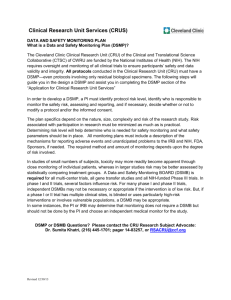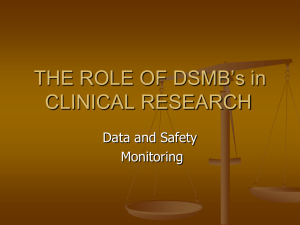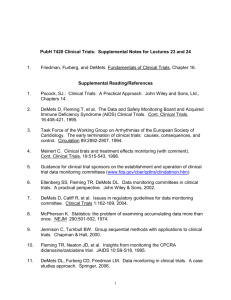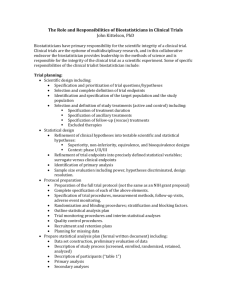DRAFT - Generic Monitoring Plan for Trials Requiring a Data Safety
advertisement
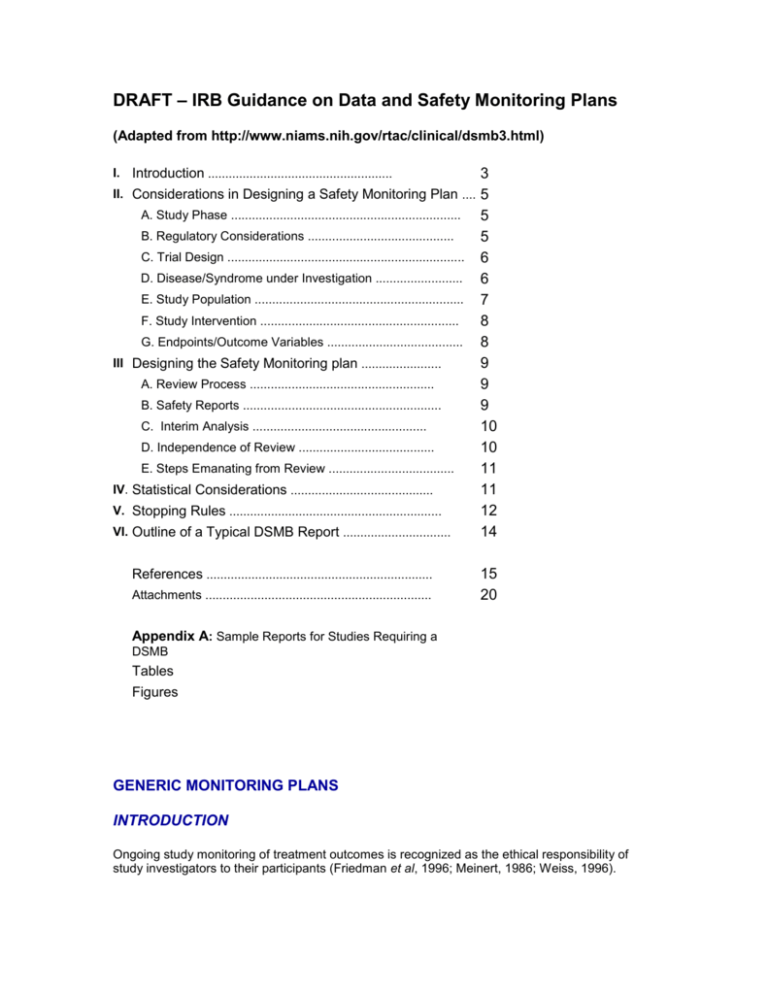
DRAFT – IRB Guidance on Data and Safety Monitoring Plans (Adapted from http://www.niams.nih.gov/rtac/clinical/dsmb3.html) 3 II. Considerations in Designing a Safety Monitoring Plan .... 5 A. Study Phase .................................................................. 5 B. Regulatory Considerations .......................................... 5 C. Trial Design .................................................................... 6 D. Disease/Syndrome under Investigation ......................... 6 E. Study Population ............................................................ 7 F. Study Intervention ......................................................... 8 G. Endpoints/Outcome Variables ....................................... 8 III Designing the Safety Monitoring plan ....................... 9 A. Review Process ..................................................... 9 B. Safety Reports ......................................................... 9 C. Interim Analysis .................................................. 10 D. Independence of Review ....................................... 10 E. Steps Emanating from Review .................................... 11 IV. Statistical Considerations ......................................... 11 V. Stopping Rules ............................................................. 12 VI. Outline of a Typical DSMB Report ............................... 14 I. Introduction ..................................................... References ................................................................. Attachments ................................................................. 15 20 Appendix A: Sample Reports for Studies Requiring a DSMB Tables Figures GENERIC MONITORING PLANS INTRODUCTION Ongoing study monitoring of treatment outcomes is recognized as the ethical responsibility of study investigators to their participants (Friedman et al, 1996; Meinert, 1986; Weiss, 1996). Safety monitoring is carried out to ensure and maintain the scientific integrity of human subjects research projects and to protect the safety of human subjects. Meinert (1986) defines safety monitoring as any process during a clinical trial that involves the review of accumulated outcome data for groups of patients to determine if any of the treatment procedures practiced should be altered or stopped. NIH Guidelines (1998) specify that all clinical trials should have a system in place for appropriate oversight and monitoring to ensure the safety of participants and the validity of the data. UTHSCSA Guidelines specify that all research studies deemed to be greater than minimal risk should be considered by the IRB for inclusion of an appropriate oversight and monitoring procedure in a data safety monitoring plan to ensure the safety of participants and the validity of the data. In addition, all studies deemed minimal risk and those greater than minimal risk in which the IRB has not deemed it necessary to develop a data safety monitoring plan will describe at a minimum how the investigator intends to monitor data with respect to safety (to assess the magnitude of adverse events, if any); and treatment (to monitor and assess treatment effects, if any.) Monitoring activities should be commensurate with the nature, size, and complexity of the trial or study. For a small, single center study, the monitoring is usually performed by a statistician in conjunction with a Safety Officer. For those single site, high risk trials, a DSMB may be in order. For larger, single or multi-center, clinical trials, monitoring is performed by committee, often called a Data and Safety Monitoring Board (DSMB). Ongoing review of the data by an independent individual or committee assures the investigators that the trial can continue without jeopardizing patient safety. Data monitoring during an ongoing study focuses on several areas: Performance - to assess sites’ performance with respect to subject recruitment, retention and follow-up, flow of data forms, protocol adherence and quality of data; Safety - to assess the magnitude of adverse events; and Treatment - to monitor and assess treatment effects. In multi-center studies, performance monitoring should be an ongoing activity performed by the study investigator and statistician, and reviewed by the DSMB. Performance data are reviewed in a blinded fashion, often in aggregate by site, and thus do not raise unblinding or bias issues. Ongoing safety review of the data is also performed by the investigator and statistician, and safety reports are reviewed at regularly scheduled DSMB meetings. In some studies where the treatment may be toxic or potentially result in severe adverse events, the protocol may specify an unblinded safety review by the study statistician or an independent clinician. Treatment monitoring or interim analyses by the statistician is a formal process that is specified in the protocol or by the DSMB. An interim analyses can result in early study termination if continuation will not produce benefit to patients or if the treatment outcome is known to have benefit. Meinert (1986) points out that ethical questions arise if studies continue beyond where the outcome is known and cites the Tuskegee Syphilis Study as an example. In this study, patients with syphilis were allowed to continue in the study for years even though it was known that the treatment under study, penicillin, was beneficial. Stopping rules, developed and implemented early in a study, specify the conditions under which a study may be stopped. UTHSCSA recognizes that setting up the procedures for study monitoring and for developing reports for the DSMB can be a daunting task for investigators embarking on their first multi-center study. This Guide provides a general approach to developing monitoring plans and incorporates the following: A list of issues to consider when developing a study safety monitoring plan that can form a checklist; A discussion of statistical issues and stopping rules along with examples and references; and An outline of DSMB data reports along with sample data presentations, their rationale and general data elements to be included. CONSIDERATIONS IN DESIGNING A SAFETY MONITORING PLAN There is no simple formula for how often data should be reviewed or how frequently a monitoring committee should meet. These decisions are usually set out in the protocol by the study statistician and are reviewed by the DSMB, who may develop a set of bylaws that govern these activities. To assist the study team and the DSMB in formulating the safety monitoring plan, the following considerations should be reviewed. Study Phase Study Phase Phase I, II and III studies generally require different levels of safety monitoring scrutiny. For many phase I and phase II trials, independent DSMBs may not be necessary or appropriate when the intervention is low risk or because of their small size and short duration. Instead, continuous, close monitoring by the study investigator in conjunction with a Safety Officer may be an adequate and appropriate format for monitoring, with prompt reporting of toxicity to the IRB, FDA and/or NIH. In situations involving potentially high risks or special populations, investigators must consider additional monitoring safeguards. For example, for studies involving children, investigators may consider the use of a consent monitor to ensure that informed consent or assent is properly administered. In addition, those trials with high risk (gene transfer, stem cell, etc.) will require a DSMB. As studies progress through Phase II and III, a DSMB is required. As the intensity and frequency of safety monitoring increases and as the number of subjects and sites increase, dosing levels are tested, and subjects are randomized to interventions. The need to document the safety profile of the drug, or likely adverse events, and to insure data integrity requires more frequent and more rigorous views of the data. Regulatory Considerations There are additional administrative considerations if the clinical trial requires compliance with FDA regulations. Monitoring should conform to Good Clinical Practice (GCP) and International Committee on Harmonization (ICH) guidelines. Study phase (I-III) and plans for IND submission also influence the frequency and intensity of monitoring studies. Pivotal studies that will influence the outcome of an IND are generally subjected to rigorous monitoring. While it is often argued that the safety profile of a drug is known by the time a Phase III is conducted, early studies are generally conducted in small populations. Thus adverse events may remain undetected. Further, other safety concerns such as futility of outcome, protocol adherence, site performance, and data quality need careful scrutiny. Trial Design The design of the trial is, in part, related to the study phase. As studies move from Phase I through Phases II and III, more subjects are required, and again, greater variability in both study implementation and subject population may occur. In addition, adverse events are more likely to emerge as more people are exposed to the intervention. In multi-center clinical trials, there is greater need to examine site specific data collection and outcomes and inter-site differences. Later Phase II and all Phase III studies are generally designed as randomized, controlled, clinical trials. Because the subject and investigator are blinded it cannot be determined if the adverse events that occur are related to the drug. Thus, careful review of the data both aggregate and by treatment group in a blinded fashion should take place at regularly scheduled intervals. If adverse events occur in different proportions in the study groups and there are concerns regarding the negative effects of the intervention, then the study statistician, and/or the DSMB may decide to unblind themselves to protect the safety of the study subjects. Disease/Syndrome under Investigation The nature of the disease being studied may influence the safety monitoring plan. When the natural history of a disease is known, the investigators and the DSMB are more likely to anticipate the nature and frequency of adverse events. However, diseases involving potentially high risks or special populations, investigators must consider additional monitoring safeguards. For example, for studies involving children, investigators may consider the use of a consent monitor to ensure that informed consent or assent is properly administered. In addition, those trials with high risk (gene transfer, stem cell, etc.) will require a DSMB. A monitoring plan should consider the nature of the intervention. The level of scrutiny will depend on the severity of the disease and may require frequently scheduled safety reviews. The same approach may be needed if the disease is serious and/or life threatening and endpoints are anticipated to occur frequently and/or early in the study. Study Population The nature of the disease and the trial design will influence the size and characteristics of the subject population. Phase I and II studies have smaller subject populations and treatment studies for diseases are likely to include subjects of similar demographic and health statuses. Phase III studies have larger subject populations. Treatment studies for diseases such as heart disease and cancer and are likely to include subjects of different demographic and health backgrounds. The diversity of a study population can be controlled, to some degree, by the inclusion/exclusion criteria which determine who is eligible to participate in a study. In some studies, eligibility criteria will increase the homogeneity of the patient population. Increased homogeneity may decrease the number of confounding variables that will be considered during analysis. However, stringent inclusion/exclusion criteria may also hinder subject recruitment and accrual to the study. It is therefore important to strike a balance between these two competing demands so that subjects can be recruited to a study in a timely and cost effective manner and that the study yields results that are of high quality and confirm the efficacy of the intervention. This consideration protects the subject’s safety in that he/she is not committed to a study that is unduly extended over time or that shows no hope of successfully evaluating the intervention. The safety plan should specify a review of the rate of subject accrual by site and by the study overall, the sites’ adherence to inclusion/exclusion criteria and other protocol requirements, and the expected compliance rate of the subjects. Studies in which the study requirements are invasive, the intervention causes many adverse events, or the target population is very old, very young, or marginal (e.g., homeless, mentally ill, etc.) may have difficulty accruing and retaining subjects. Careful monitoring of the recruitment, enrollment and retention activities will help to protect the safety of study subjects, integrity of the study and the quality of the data. If subject accrual is expected to occur quickly, then safety monitoring should take place early and may be tied to a percent of the total population to be accrued. For example, if 60 subjects are to be recruited in six months, safety review can take place after the first month of enrollment or after the first 10% of the subjects are enrolled, whichever comes first. Study Intervention The more that is known about the study treatment, the easier it is to plan for the monitoring of the study. As discussed, treatments that have been studied previously are more likely to have a known safety profile and the frequency and type of adverse events can be anticipated. However, the safety of a treatment is also related to the population being treated, the indication for its use, dosing level and frequency, the presence of comorbid diseases, and the subject’s time on study drug. All of these factors need to be considered in deciding on the frequency and intensity of safety monitoring as well as the types of reports, e.g., number of adverse events per subject. Endpoints/Outcome Variables Endpoints that are well defined and immediate are easier to monitor. Acute illnesses are more likely to have these types of outcomes. For example, treatment of an acute infection with the study drug is likely to yield clear cut results in a relatively short period of time. In contrast, outcomes from chronic illnesses such as diabetes and heart disease may require a longer treatment intervention and follow-up period. Thus, the subject’s time on study intervention and in the study from baseline through final follow-up will influence the type and frequency of safety monitoring. DESIGNING THE SAFETY MONITORING PLAN Once the study design and population are specified, the clinical investigators can design, with the study statistician, the study safety monitoring plan. The monitoring plan should specify the responsibilities of the PI, Independent Monitor is utilized, and/or DMC/DSMB/DSC if utilized, including frequency of data review, triggers for ad hoc reviews, and contents and format of the administrative and safety reports. In addition, specific instructions as to whom each report will be sent [e.g., DSMB, UTHSCSA IRB, Sponsor, DAC, FDA], and what procedures, if any, the PI or recipient(s) should follow (e.g., DSMB will forward the report void of patient-specific information to sponsor) to ensure that pertinent parties receive these documents. Review Process The monitoring plan should delineate the review process and the roles of the PI, independent monitor, data management center (DMC), the study statistician, and the DSMB/DSC depending on which are utilized for the study, in relation to the content, format, and process of the review. Typically, a DMC, independent study statistician or PI (with or without the assistance of a study statistician) produces administrative reports that describe study progress including accrual by site, demographics in aggregate and by site, as well as subjects’ status in aggregate and by site. Reports might describe outstanding study forms or error rates by site and in aggregate regarding adherence to inclusion/exclusion criteria and the study protocol. These reports are reviewed internally by the DMC for ongoing quality control and are also presented to the DSMB and the sponsor, DCA, etc as noted in the protocol. For those studies not utilizing a DMC/DSMB but instead utilize an independent monitor, the monitor produces reports that describe study progress including such data as accrual by site, demographics in aggregate and by site, as well as subjects’ status in aggregate and by site, as appropriate for the study (See ‘considerations’ above), based on data received by the coordinator or PI (note procedures for "freezing" the data set described in interim analysis). Reports might describe outstanding study forms or error rates by site and in aggregate regarding adherence to inclusion/exclusion criteria and the study protocol. These reports are reviewed internally by the independent monitor for ongoing quality control then after compiling with the safety report information, a brief evaluation is prepared and sent to the PI . The Administrative and Safety Report is also presented to the sponsor, DCA, etc as noted in the protocol and if not blinded to the PI. For those studies not utilizing a DSMB, DMC or an independent monitor, the investigator produces reports as noted in their DSMP (e.g., to track reviews study data, study progress, error rates). The PI then compiles this with the safety report information and prepares a brief evaluation. The PI either receives a brief evaluation from the DSMB/independent monitor (after they review the Administrative and the Safety Reports) or if the sole monitor, the PI compiles the Administrative and the Safety Reports and creates a brief evaluation. The PI then only forwards the brief evaluation to the local IRB if the evaluation constitutes an unanticipated problem involving risk to subjects or others (UPIRSO) as per local IRB rules. At UTHSCSA this must be attached to a UPIRSO report form explaining how this constitutes a UPIRSO. Those Reports and brief evaluations that are collected during the year must be reported in summary to the UTHSCSA IRB as part of continuing review annually. Safety Reports If a DMC is utilized, it also produces safety reports that list adverse events, serious adverse events, deaths, and disease or treatment specific events by site and in aggregate for DSMB meetings. In some studies of treatments with an unexpected high toxicity, an independent medical monitor may review each adverse event or treatment description to ensure good clinical care and to quickly identify any potential trends. In other studies, the statistician may review data routinely and will alert the sponsor and the DSMB if event rates are of statistical concern, occur in a disproportionate number in one of the treatment groups, or fall out of a pre-determined set of boundaries. The study statistician may distribute interim reports to the DSMB between meetings to allow members to call special sessions when appropriate. In some studies, the Statistical Coordinating Center (SCS) is separate from the DMC. In these cases, the DMC may prepare reports for the SCC or may send the SCC the data. The review plan should specify the process for reporting safety concerns among the medical monitor, the IRB, DSMB, sponsor and, if appropriate, the FDA. Typically, the DSMB reviews the safety reports in aggregate fashion and by blinded treatment group. If there are a significant number of adverse events, the DSMB may request that the treatment groups be unblinded to ensure that there are not untoward treatment effects. The review plan should specify how data are to be presented and triggers for presenting safety data in an unblinded manner. For those studies not utilizing a DMC/DSMB, but instead utilize an independent monitor, the monitor produces safety reports that list adverse events, serious adverse events, deaths, and disease or treatment specific events by site. These reports are reviewed internally by the independent monitor, compiled with the administrative report information, then a brief evaluation is prepared and sent to the PI . The Administrative and Safety Report is also presented to the sponsor, DCA, etc as noted in the protocol and if not blinded to the PI. For those studies not utilizing a DSMB, DMC or an independent monitor, the investigator produces safety reports that list adverse events, serious adverse events, deaths, and disease or treatment specific events by site. The PI then compiles this with the administrative report information and prepares a brief evaluation. The PI either receives a brief evaluation from the DSMB/independent monitor (after they review the Administrative and the Safety Reports) or if the sole monitor, the PI compiles the Administrative and the Safety Reports and creates a brief evaluation. The PI then only forwards the brief evaluation to the local IRB if the evaluation constitutes an unanticipated problem involving risk to subjects or others (UPIRSO) as per local IRB rules. At UTHSCSA this must be attached to a UPIRSO report form explaining how this constitutes a UPIRSO. Those Reports and brief evaluations that are collected during the year must be reported in summary to the UTHSCSA IRB as part of continuing review annually. Interim Analysis If a DMC is utilized it also prepares the data for the study statistician to analyze in conformance with an interim analysis. The coordinator must have procedures in place for preparing the data for the analyses and for "freezing" the data set so that additional analyses may be performed or the analyses recreated, if necessary. The schedule for interim analyses can be a fixed time frame (e.g., every six months), after a certain number or percentage of subjects are enrolled (e.g., 25%, 50%, 75%, 100%), or in response to a specific number of occurrences of an event (e.g., n deaths). For those studies not utilizing a DMC/DSMB, but instead utilize an independent monitor, the monitor, if interim analyses are planned for the study, prepares the data for the study statistician to analyze in conformance with an interim analysis. The coordinator must have procedures in place for preparing the data for the analyses and for "freezing" the data set so that additional analyses may be performed or the analyses recreated, if necessary. The schedule for interim analyses can be a fixed time frame (e.g., every six months), after a certain number or percentage of subjects are enrolled (e.g., 25%, 50%, 75%, 100%), or in response to a specific number of occurrences of an event (e.g., n deaths). For those studies not utilizing a DSMB, DMC or an independent monitor, the investigator, if interim analyses are planned for the study, prepares the data for the study statistician to analyze in conformance with an interim analysis. The coordinator must have procedures in place for preparing the data for the analyses and for "freezing" the data set so that additional analyses may be performed or the analyses recreated, if necessary. The schedule for interim analyses can be a fixed time frame (e.g., every six months), after a certain number or percentage of subjects are enrolled (e.g., 25%, 50%, 75%, 100%), or in response to a specific number of occurrences of an event (e.g., n deaths). Independence of Review The DSMB should be separate and independent from the clinical staff or anyone responsible for patient care. Members of the DSMB should not have scientific, financial, or other conflict of interest related to the trial. Current or past collaborators or associates of the PI (i.e., same institution) are not eligible. Clinicians should be blinded to the safety monitoring data, as exposure to emerging trends may influence enrollment and care, thus biasing the study. For those studies without a formal DSMB but for which a DSMP is still required it is preferred to maintain a separate and independent individual or entity to oversee the data who is free from scientific, financial, or other conflict of interest related to the trial or study, if practicable. For those studies for which no formal DSMP is required, it is expected that the investigator will act as the safety and treatment oversight for the study but a separate and independent individual or entity may be chosen to oversee the data and safety in addition to the investigator, if practicable. Steps Emanating from Review The monitoring plan should also specify what steps will be taken as a result of the review and should consider the impact of the review on the study. Statistical considerations, such as alpha spending and early stopping are discussed below in the section on statistical issues. The review may result in an amendment to the protocol, which must be approved by the IRB, sponsor, and the DSMB. If the review causes changes to the data collection plan or study forms, then there should be a set of procedures for documenting and implementing these changes since the study data sets and analyses may also be affected. STATISTICAL CONSIDERATIONS Statistical issues arise with ongoing data monitoring such as the "multiple testing" problem, spending the study "alpha", and powering the study for "multiple looks." These issues and associated methods are addressed in the monitoring plan and are briefly discussed. References provide more robust discussion of these issues. "Multiple looks" at the data during interim analyses can reduce the power of a study. Thus, there is an inverse relationship between the number of interim analyses and the interim p-values for significance. Pocock (1977) recommends that the significance levels for all interim analyses be the same. For example, assuming five interim analyses, a significance level of 1.6% achieves an overall 5% significance. O’Brien and Fleming (1979) modify this rule so that the significance levels begin lower and end at the final analysis closer to the desired overall significance level. The adjustment of the analytic plan and significance level(s) for interim analysis is referred to as the ‘alpha spending’ function. The ‘boundary conditions’ described by the interim and final significance levels are symmetrically 2-sided if it is important to measure both the potential positive and negative effects of a treatment vis-à-vis the placebo. STOPPING RULES A ‘stopping rule’ specifies the outcome differences detected between groups during an interim analysis that can stop a clinical trial or study. The stopping rules reflect one of the following conditions: there is clear evidence of harm or harmful side-effects of the treatment; there is no likelihood of demonstrating treatment benefit; or there is overwhelming evidence of the benefit of the treatment. One of the benefits of stopping rules is that they can prevent over-reaction to random highs or lows in treatment response rates and adverse events since they generally require very low threshold p-values in interim analyses to indicate significance. However, stopping rules, also called ‘discontinuation guidelines,’ are not sufficient to justify stopping a trial for several reasons: New Information - There may be new information available such as the results of other trials, a change in the understanding of the underlying biology or outside evidence of unacceptable adverse effects. Limits of Assumptions - Assumptions in the trial design regarding sample size and power, subject recruitment, the adverse event profile, and anticipated treatment affect differences may prove to be false when the trial is underway. Limits of Rules - Rules can not be developed for all potential study scenarios and contingencies. Stopping a trial early, even if justified, has consequences. The scientific purpose behind clinical trials is to calculate with some assurance the size of the differences between treatment outcome. With less than a full complement of events recorded, the confidence intervals associated with estimates of treatment effects are larger. Another consequence of early stopping is to bias the estimates of treatment effect upward. This bias occurs because random high values in treatment effect may be used to justify early stopping, but rarely would random low values be so used. Stopping rules should be defined in the statistical plan or early in a study and require realistic estimates of sample size to be effective. Optimistic subject accrual projections often mean that the trial is unable to show the test effect with the necessary assurance. Stopping rules are no more reliable than the data on which they are based. Thus, the quality of the data must be ascertained for the interim analyses. Before employing stopping rules, there are a host of issues that should be considered, according to Friedman (1996): Group Differences - Possible differences in baseline characteristics and prognostic factors between the two groups should be explored and necessary adjustments made in the analysis. Response Variables - Potential bias in the assessment of response variables must be considered, especially when the trial is not doubleblind. Missing Data - Possible impact of missing data should be evaluated. For example, could the conclusions be reversed if the experience of participants with missing data from one group were different from the experience with missing data from the other group? Protocol Compliance - Different participant protocol compliance should be evaluated for possible impact. Side Effects - Potential side effects and outcomes of secondary response variables should be considered in addition to the outcome of the primary response variable. Subgroup Consistency - Internal consistency across subgroups and various outcome measures should be examined. Relevant statistical methods used in monitoring include classical or group sequential methods, flexible group sequential procedures, applications of group sequential boundaries, asymmetric boundaries, curtailed sampling procedures, and other approaches. These methods are discussed in numerous statistical methods books for clinical trials, a few of which are included in the bibliography. OUTLINE OF TYPICAL ADMINISTRATIVE AND SAFETY REPORT Attachment A contains an outline for a typical Administrative and Safety (DSMB) Report that is prepared by the study's Data Management or Statistical Coordinating Center, depending upon the structure and nomenclature of a specific study. The report begins with a brief narrative section that describes the status of the study, progress or findings to-date, issues, and the procedures that produced the report (e.g., data obtained by a specific date). The report provides a study description along with a current organization chart, current timetable and study schedule as well as a list of study clinical and administrative centers. Data are then presented that describe the administrative status of the study including recruitment and forms handling. Study data reports describe demographic and baseline clinical characteristics and provide a safety assessment. These tables are generally provided by site as well as for the whole study population. The intent of the tables in this section is to provide a general scope of a typical report. The specifics of the study (i.e., the patient population, severity of the disease, and treatment) will guide the requirement for any tables necessary for routine reports and interim analyses. After receipt and review of the Administrative and Safety Report, the DSMB, if utilized, sends a brief evaluation, with recommendations as to whether or not the trial will continue, to the sponsor, DAC, the PI, etc. as indicated in the protocol. The PI only forwards this brief evaluation to the local IRB if the evaluation constitutes an unanticipated problem involving risk to subjects or others (UPIRSO) as per local IRB rules. At UTHSCSA this must be attached to a UPIRSO report form explaining how this constitutes a UPIRSO. REFERENCES Armstrong PW; Furberg CD. Clinical Trial Data and Safety Monitoring Boards. The Search for a Constitution [editorial]. Circulation 1995(Feb1);91(3):901-4. Ashby D; Machin D. Stopping Rules, Interim Analysis and Data Monitoring Committees [editorial]. Br J Cancer 1993(Dec);68(6):1047-50. Bauer P; Kohne K. Evaluation of Experiments with Adaptive Interim Analysis. Biometrics 1994(Dec);50(4):1029-41. Baum M; Houghton J; Abrams K. Early Stopping Rules—Clinical Perspectives and Ethical Considerations. Stat Med 1994(July 15-30);13(13-14):1459-69; discussion 1471-2. Berntsen RF; Rasmussen K; Bjornstad JF. Monitoring a Randomized Clinical Trial for Futility: the North-Norwegian Lidocaine Intervention Trial. Stat Med 1991(Mar);10(3):405-12. Burke G. Discussion of ‘Early Stopping Rules-Clinical Perspectives and Ethical Considerations’. Statistics in Medicine 1994;13:1471-1472. Buyse M.. Interim Analysis, Stopping Rules and Data Monitoring in Clinical Trials in Europe. Stat Med 1993(Mar);12(5-6):509-20. Christiansen DH; Sundin D. A Data Model for Clinical Study Status Reports. Drug Information Journal 1998;32:887-895. Chuang-Stein C. Safety Analysis in Controlled Clinical Trials. Drug Information Journal 1998;32:1363S-1372S. Chow, Shein-Chug. Good Statistics Practice in the Drug Development and Regulatory Approval Process. Drug Information Journal 1997;31:1157-1166. Cullen DJ; Bates DW; Small SD; Cooper JB; Nemeskal AR; Leape LL. The Incident Reporting System Does not Detect Adverse Drug Events: a Problem for Quality Improvement. Jt Comm J Qual Improv 1995(Oct);21(10):541-548. DeMets DL; Fleming TR; Whitley RJ; Childress JF; Ellenberg SS; Foulkes M; Mayer KH; O’Fallon J; Pollard RB; Rahal JJ; Sande M; Straus S; Walters L; Whitley-Williams P. The Data and Safety Monitoring Board and Aquired Immune Deficiency Syndrome (AIDS) Clinical Trials. Controlled Clinical Trials 1995;16:408-421. Dutar C; Otun EO. A Worldwide Strategy for Dictionary Management. Drug Information Journal 1996;30:137-142. Ellenberg SS; Myers MW; Blackwelder WC; Hoth DF. The Use of External Monitoring Committees in Clinical Trials of the National Institute of Allergy and Infectious Diseases. Statistics in Medicine 1993(Mar);12(5-6):461-467; discussion 469. Ellenberg SS. The Use of Data Monitoring Committees in Clinical Trials. Drug Information Journal 1999;30:553-557. Fairweather WR. Integrated Safety Analysis: Statistical Issues in the Assessment of Safety in Clinical Trials. Drug Information Journal 1996;30:875-879. Freidlin B; Korn EL; George SL. Data Monitoring Committees and Interim Monitoring Guidelines. Controlled Clinical Trials 1999;20:395-407. Friedman LM; Furberg CD; DeMets DL. Fundamentals of Clinical Trials. Mosby-Year Book, Inc.: 1996. Heitjan DF; Houts PS; Harvey HA. A Decision-Theoretic Evaluation of Early Stopping Rules. Stat Med 1992(Mar);11(5):673-83. Hughes MD; Freedman LS; Pocock SJ. The Impact of Stopping Rules on Heterogeneity of Results in Overviews of Clinical Trials. Biometrics 1992(Mar);48(1):41-53. Kim K; Tsiatis AA. Study Duration for Clinical Trials with Survival Response and Early Stopping Rule. Biometrics 1990(Mar);46(1):81-92. McPherson K. Sequential Stopping Rules in Clinical Trials. Stat Med 1990(Jun);9(6):595-600. Meinert CL. Clinical Trials: Design, Conduct, and Analysis. Oxford University Press, New York: 1986. National Institute of Health (1998, June 10). NIH Policy for Data Safety Monitoring [Online]. Available HTTP: Http://www.nih.gov/grants/guide/notice-files/not98-084.html O’Brien PC; Fleming TR. A multiple testing procedure for clinical trials. Biometrics 1979;35:549556. Pignon JP; Arriagada R. Early Stopping Rules and Long-term Follow-up in Phase III Trials. Lung Cancer 1994(Mar);10 Suppl 1:S151-9. Pocock SJ. Group sequential methods in the design and analysis of clinical trials. Biometrika 1977;64:191-199. Pong A; Shein-Chung C. Statistical/Practical Issues in Clinical Trials. Drug Information Journal 1997;31:1167-1174. Routledge PA; Biala MC; Houghton JE; Woods F. Adverse Drug Reactions: The Great Masqueraders. Drug Information Journal 1998;32:79-84. Sankoh AJ. Interim Analyses: An Update of an FDA Reviewer’s Experience and Perspective. Drug Information Journal 1999;33:165-176. Shein-Chung C. Good Statistics Practice in the Drug Development and Regulatory Approval Process. Drug Information Journal 1997; 31:1157-1166. Singer, DE. Problems with Stopping Rules in the Trials of Risky Therapies: the Case of Warfarin to Prevent Stroke in Atrial Fibrillation. Clin Res 1993(Oct);41(3):482-6. Souhami, Robert L. The Clinical Importance of Early Stopping of Randomized Trials in Cancer Treatments. Statistics in Medicine 1994;13:1293-1295. Schwarz, PJ. How Reliable are Clinical Trials? The Importance of the Criteria for Early Termination. Eur Heart J 1995(Aug);16 Suppl G:37-45. Thall PF; Simon RM; Estey EH. Bayesian Sequential Monitoring Designs for Single-Arm Clinical Trials with Multiple Outcomes. Statistics in Medicine 1995;14:357-379. Wallander MA; Lundborg P; Svardsudd K. Adverse event monitoring in clinical trials of felodipine and omeprozole. Eur J Clin Pharmacol 1992;42(5):517-522. Weiss NS. Clinical Epidemiology: The Study of Outcome of Illness. Oxford University Press; New York: 1996. Winkler G; Marsh R. Creating a Successful CRO-Sponsor Relationship Through Alignment of Goals and Values. Drug Information Journal 1996;30:113-117. Wittes J. Behind Closed Doors: The Data Monitoring Board in Randomized Clinical Trials. Statistics in Medicine 1993;12:419-424. Zidek W; Spiecker C; Knaup G; Steindl L; Breuer HW. Comparison of the Efficacy and Safety of Nifedipine Coat-Core Versus Amlodipine in the Treatment of Patients with Mild-to-Moderate Essential Hypertension. Hypertension Study Group. Clin Ther 1995(Jul-Aug);17(4):686-700. Appendix A: Sample Reports for Studies Requiring a DSMB In general your monitoring plan should include a statement as to who your DSMB members are (if approved prior to the writing of the plan) or what type of credentials your intended DSMB members will possess. The plan should list all information to be included in reports, with copies of the reports intended, and at what intervals throughout the trial the DSMB receive trial updates. In addition, specific instructions as to whom each report will be sent [e.g., DSMB, IRB (, Sponsor, FDA], and what procedures, if any, the PI or recipient(s) should follow (e.g., DSMB will forward the report void of patient-specific information to sponsor) to ensure that pertinent parties receive these documents. The following is an outline of the type of report the DSMB should receive: I. Table of Contents II. Narrative/Trial Summary A. Summary of Main Findings B. Discussion of Issues or Problems C. Report Preparation Procedures III. Study Description A. Project Organizational Chart, Personnel B. Brief Statement of Purpose of Trial C. Projected Timetable and Schedule D. List of Participating Clinics, Data Centers, Resource Centers IV. Study Administration A. Recruitment and Subject Status Table 1: Site Enrollment by Year or Month of Study Figure 1: Comparison of Target to Actual Enrollment by Month Figure 2: Comparison of Target to Actual Enrollment by Site Table 2: Overall Subject Status by Site Table 3: Subject Status-Detail by Site B. Forms Status Table 4: Data Flow to Coordinating Center By Visit and Site Table 5: Status of Forms at Coordinating Center V. Study Data Reports (including Interim Analysis) A. Recruitment and Subject Status Table 6: Race/Ethnic Characteristics by Site Table 7: Demographic and Key Baseline Characteristics by Group B. Safety Assessment For All Subjects [may also be recorded by Blinded Treatment Group (closed session)] Table 8: Treatment Duration for All Subjects Table 9: Treatment Duration for Subjects Who Discontinue Therapy Table 10: Adverse Events by Site and Subject Table 11: Serious Adverse Events by Site and Subject Table 12: Deaths by Site Table 13: Frequency of Specific Symptoms Table 14: Observed Adverse Events by Body System Table 15: Laboratory Data By Patient (Relevant Labs) Out of Range Values Table 16: Subject Status by Site and Group Figure 3: Average Cumulative Dose by Group TABLE 1. SITE ENROLLMENT BY YEAR OR MONTH OF STUDY Date: __________________ Site Number First Patient Last Patient 1999 2000 Total(%) and Name Enrolled Enrolled 1 2 3 4 N Total TABLE 2. OVERALL SUBJECT STATUS BY SITE Date: __________________ Site Number Date Date Terminated/Dropped Screened Active and Enrolled Completed Out (reason) Name 1 2 3 4 N Total TABLE 3. SUBJECT STATUS-DETAIL BY SITE Date: _________________________ Terminated
